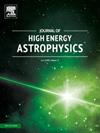Shadows of rotating hairy black holes surrounded with quintessence and constraints from EHT observations
IF 10.2
4区 物理与天体物理
Q1 ASTRONOMY & ASTROPHYSICS
引用次数: 0
Abstract
The Event Horizon Telescope (EHT) collaboration recently unveiled the first image of the supermassive black hole M87*, which exhibited a ring of angular diameter , a circularity deviation , and also inferred a black hole mass of . The shadow of Sgr A⁎ has an angular diameter as with fractional deviation from the Schwarzschild black hole shadow diameter (for the VLTI and Keck mass-to-distance ratios). The image of the supermassive black holes M87* and SgrA* opened new avenues for testing gravitational theories in extreme regimes. While current observations align with the Kerr black hole model, they cannot conclusively support or reject any specific black hole model. Motivated by this, we use the gravitational decoupling approach to derive an exact rotating hairy Kiselev black hole solution, which incorporates the effects of a quintessence parameter ω and a hairy parameter l. Using this solution, we investigate the shadows of rotating hairy black holes surrounded by quintessence, focusing on constraints derived from EHT observations. We explore the effects of quintessence and hairy parameters on the shadows of rotating Kiselev black holes, analyzing how these parameters deviate from the Kerr geometry and influence the black hole's horizon structure, geodesics, and shadow morphology. Our study reveals that the shadow radius, distortion, and other observables are significantly affected by the quintessence state parameter ω, the hairy parameter l, and the spin parameter a. Through a detailed analysis of the shadow's behavior, including the impact of observer inclination and the parameter space constraints, we derived bounds on these parameters consistent with EHT observations of M87* and SgrA*. We calculate the circularity deviation, angular diameter, and Schwarzschild deviation, showing that while the current EHT data cannot distinguish between the shadows of hairy Kiselev and standard Kerr black holes, future observations, such as those from ngEHT, may provide more precise constraints and potentially reveal signatures of dark energy.
求助全文
约1分钟内获得全文
求助全文
来源期刊

Journal of High Energy Astrophysics
Earth and Planetary Sciences-Space and Planetary Science
CiteScore
9.70
自引率
5.30%
发文量
38
审稿时长
65 days
期刊介绍:
The journal welcomes manuscripts on theoretical models, simulations, and observations of highly energetic astrophysical objects both in our Galaxy and beyond. Among those, black holes at all scales, neutron stars, pulsars and their nebula, binaries, novae and supernovae, their remnants, active galaxies, and clusters are just a few examples. The journal will consider research across the whole electromagnetic spectrum, as well as research using various messengers, such as gravitational waves or neutrinos. Effects of high-energy phenomena on cosmology and star-formation, results from dedicated surveys expanding the knowledge of extreme environments, and astrophysical implications of dark matter are also welcomed topics.
 求助内容:
求助内容: 应助结果提醒方式:
应助结果提醒方式:


